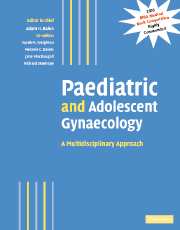Book contents
- Frontmatter
- Contents
- Contributors
- Preface
- Part I Normal development
- Part II Management of developmental abnormalities of the genital tract
- 9 Management of ambiguous genitalia at birth
- 10 Imaging of the female pelvis in the evaluation of developmental anomalies
- 11 Surgical correction of vaginal and other anomalies
- 12 Laparoscopic techniques
- 13 A nonsurgical approach to the treatment of vaginal agenesis
- 14 Psychological care in disorders of sexual differentiation and determination
- 15 The needs of the adolescent patient and her parents in the clinic
- 16 Communicating a diagnosis
- 17 Patients and parents in decision making and management
- Part III Management of specific disorders
- Index
- Plate section
- References
17 - Patients and parents in decision making and management
from Part II - Management of developmental abnormalities of the genital tract
Published online by Cambridge University Press: 04 May 2010
- Frontmatter
- Contents
- Contributors
- Preface
- Part I Normal development
- Part II Management of developmental abnormalities of the genital tract
- 9 Management of ambiguous genitalia at birth
- 10 Imaging of the female pelvis in the evaluation of developmental anomalies
- 11 Surgical correction of vaginal and other anomalies
- 12 Laparoscopic techniques
- 13 A nonsurgical approach to the treatment of vaginal agenesis
- 14 Psychological care in disorders of sexual differentiation and determination
- 15 The needs of the adolescent patient and her parents in the clinic
- 16 Communicating a diagnosis
- 17 Patients and parents in decision making and management
- Part III Management of specific disorders
- Index
- Plate section
- References
Summary
So now, where should they begin? How should they co-ordinate their slow crawl back from the desert? What should they say? What could they tell people? Who was entitled to the whole story and who could be kept at a distance with a half-truth?
Anna's parents knew the facts — knew the possibilities, that is — but then settled for not talking about them. They pretended that they were sparing their daughter's feelings, but really they were sparing their own. Nothing in their lives had prepared them for catastrophe.
Hilary Mantel, 1995Patients and parents whose lives are affected by intersex conditions such as androgen insensitivity syndrome (AIS) have chances to influence decision making and management both in the clinical setting and in the family. The prime qualifications for this are a knowledge-base and confidence to articulate concerns and information to doctors, family, partners and friends. This chapter explores some of the psychology of being a patient or a parent under these circumstances so that clinicians can better understand their needs and idosyncrasies in relation to some medical conditions that have been subject to a great deal of ignorance, secrecy, shame and taboo.
We shall examine chronologically, from birth to adulthood, the issues that affect decision making, bringing in parental issues. The basic assumptions are (i) that the doctors have truthfully disclosed the full diagnosis, at least to the parents, (ii) that we are considering decisions made not only in the clinical setting but also in the outside life of the parents/adults concerned, (iii) that the observations relate mainly to AIS and similar conditions, and (iv) that we are considering patients at the female end of the male—female continuum since that is the main area of experience/expertise of the AIS Support Group (AISSG) and since this is a gynaecology textbook.
- Type
- Chapter
- Information
- Paediatric and Adolescent GynaecologyA Multidisciplinary Approach, pp. 205 - 228Publisher: Cambridge University PressPrint publication year: 2004
References
- 2
- Cited by



